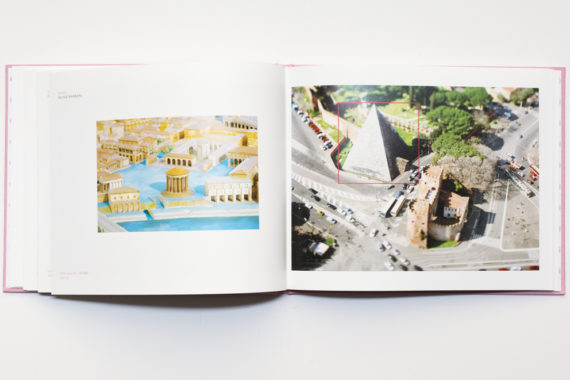Descrizione
[:it]Nel 2004, FOTOGRAFIA – Festival Internazionale di Roma era ancora ai suoi albori, ma si presentava già come un festival con una sua forte identità. L’anno precedente con Josef Koudelka avevamo dato vita alla Commissione Roma, uno dei tratti più distintivi del festival e che, quattordici anni dopo, ancora lo accompagna. L’anno successivo, per continuare a ritrarre Roma, fu scelto Olivo Barbieri che già da tempo lavorava sempre attento alle mutazioni metropolitane e al rapporto tra realtà e virtualità. Nelle bellissime giornate di luce tersa di Febbraio, Olivo prese letteralmente il volo a bordo di un elicottero e iniziò a sorvolare la città di Roma: nasceva l’ormai più che decennale progetto site specific_ .
Nel corso degli undici anni successivi due percorsi si svilupparono parallelamente: mentre Roma ogni anno vedeva un nuovo fotografo ritrarla (Anders Petersen venne dopo Olivo e poi seguirono Martin Parr, Graciela Iturbide, Gabriele Basilico, Guy Tillim, Tod Papageorge, Alec Soth, Paolo Ventura, Tim Davis ed io stesso nel 2014), Olivo macinava città in giro per il mondo sorvolandole dall’alto e fotografandole (Roma, Montreal, Jordan, Shanghai, Las Vegas, Los Angeles, Torino, Malaga, Las Vegas, New York, Beijing, Monza, Modena, San Francisco, Brasilia, Manaus, L’Aquila, Milano, Catania, Firenze, Genova, Napoli, Venezia, Bangkok, Detroit, Chicago, Rio de Janeiro, Mexico City, Gibellina, Istanbul, Tel Aviv, New Orleans, Emilia, London, Memphis, Los Angeles, Houston, Sao Paulo) una dopo l’altra. Dieci anni dopo Olivo ha chiuso un cerchio. Da quell’idea iniziale di fotografare Roma come se fosse un plastico di se stessa e che ha dato vita ai ritratti di molte altre città affinando e adattando di volta in volta la tecnica, Olivo è tornato proprio a Roma, nel Museo della Civiltà Romana, a fotografarne il plastico.[:en]In 2004, FOTOGRAFIA – International Festival of Rome was still in its infancy, but already it appeared like a festival with its own strong identity. The previous year, with Josef Koudelka had given birth to the Commission Rome, one of the most distinctive features of the festival and that, fourteen years later, still accompanies the festival. The following year, to continue to portray Rome, was chosen Olivo Barbieri who has long worked always attentive to metropolitan mutations and the relationship between reality and virtuality. In the beautiful days of clear light in February, Olivo took literally an helicopter and began to fly over the city of Rome, the more than ten years the project site specific_ born.
Over the next eleven years two courses were developed in parallel: while Rome every year saw a new photographer portraying it (Anders Petersen came after Olivo and then followed Martin Parr, Graciela Iturbide, Gabriele Basilico, Guy Tillim, Tod Papageorge, Alec Soth, Paolo Ventura Tim Davis and myself in 2014), Olive grind cities around the world from above flyover and photographing them (Rome, Montreal, Jordan, Shanghai, Las Vegas, Los Angeles, Turin, Malaga, Las Vegas, New York, Beijing , Monza, Modena, San Francisco, Brasilia, Manaus, L’Aquila, Milan, Catania, Florence, Genoa, Naples, Venice, Bangkok, Detroit, Chicago, Rio de Janeiro, Mexico City, Gibellina, Istanbul, Tel Aviv, New Orleans , Emilia, London, Memphis, Los Angeles, Houston, Sao Paulo), one after another. Ten years after Olivo has closed a circle. From initial idea to photograph Rome as if it were a model of itself and that gave life to the portraits of many other cities refining and adapting each time the technique, Olivo is back in Rome itself, in the Museum of Roman Civilization, to photograph in the plastic.[:]


























